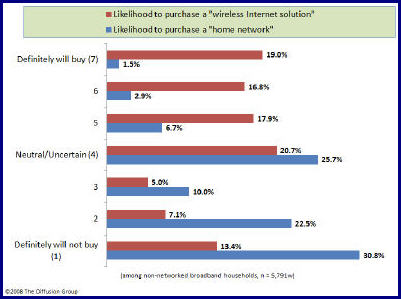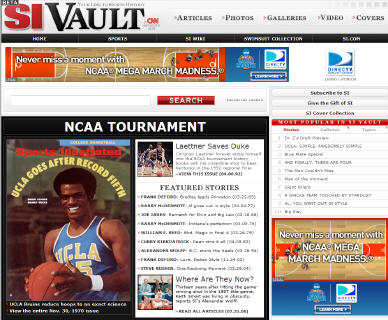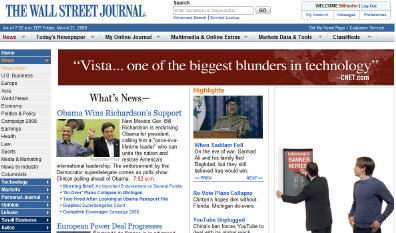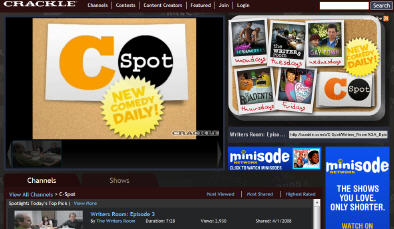-
Sony Launches C-Spot Comedy Series
The stampede into broadband-only comedy shorts continued yesterday with Sony launching "C-Spot". The six short series will run on Sony's Crackle.com, YouTube, AOL Video, Hulu, Verizon Wireless' VCAST and others likely to come.
Comedy has been such a popular genre online because it is cheap to produce, easy to digest in short bursts and doesn't require story narratives to be compelling. What we've seen to date largely appeals to the young male demo which can't seem to get enough of the gross-out or sophomoric skits or hot ladies delivering goofy laugh lines.
I sampled a few of C-Spot's new programs and while I won't pretend to be a professional reviewer, I did find them to be a cut above some of the average comedic fare I've found elsewhere. Plus I think Sony's onto something by serializing these shorts and releasing new episodes on specific days of the week.
Though broadband is truly an on-demand medium, I continue to believe that audience-building requires habituation that is only driven by regularly-scheduled new releases. Prom Queen (though not a comedy) met with success by serializing, and I've been surprised there haven't been more imitators to date.
Regardless of format, I'm expecting comedy will remain the broadband medium's hottest genre, attracting indies and established players alike.
Categories: Aggregators, Studios
-
Disney to Sell ABC to Jobs, Will Focus on Broadband Only
In a startling development, VideoNuze has confirmed that The Walt Disney Company has decided to sell its ABC television network to Apple CEO Steve Jobs, who is also Disney's largest individual shareholder.
 Disney is planning to devote most of the billions in proceeds to developing broadband-delivered video webisodes.
Disney is planning to devote most of the billions in proceeds to developing broadband-delivered video webisodes. The sale, which was unexpected, is certain to ripple throughout the entire media and technology landscape. It is a highly unorthodox transaction that experts believe will be heavily challenged by other Disney shareholders who will claim the deal exceeded CEO Bob Iger's individual authority.
The deal was concluded following a high-stakes poker game held at Iger's Brentwood, CA mansion on Saturday night, in which Jobs and other media and technology industry heavyweights participated. Though the Iger-Jobs relationship has been described publicly as cordial, apparently a series of raises, bluffs and too many scotches laid bare a simmering rivalry between the two moguls.
VideoNuze has learned that with no limits in place, the two CEOs became embroiled in a titanic game of 7 card stud, leading to a round of ante raising that left other players - who had long since folded - gasping. With their chips exhausted, Iger is said to have wagered his double titanium American Express card with a $1 million dollar limit, only to be matched by Jobs placing his unique gold-plated iPhone (believed to work on a private AT&T Wireless frequency that AT&T granted to Jobs in order to gain the lucrative iPhone exclusive) on the table.
Within minutes Jobs further raised the ante by offering up all of his Apple shares. Unable to see the multi-
 billion dollar raise, Iger and Jobs were able to shake hands on a preliminary deal, allowing Iger to throw ABC into the pot, seeing Jobs's Apple shares. When Jobs revealed 4 aces to Iger's 4 kings, the lawyers were summoned to begin papering the deal.
billion dollar raise, Iger and Jobs were able to shake hands on a preliminary deal, allowing Iger to throw ABC into the pot, seeing Jobs's Apple shares. When Jobs revealed 4 aces to Iger's 4 kings, the lawyers were summoned to begin papering the deal.Explaining what will surely be viewed as a rash move, Iger is said to have told Disney executives that from a strategic perspective his bet in fact made sense. His rationale: that the first month of results from Stage 9, Disney's new digital studio provided him ample data that broadband-delivered video was worthy of its hype and that he wanted to go "all in" with a multi-billion dollar commitment. That thinking left Wall Street observers stunned, as the only Stage 9 program that has launched to date is the comedy short, "Squeegees." The program has garnered several hundred thousand views on YouTube, but has generated no revenue.
Commenting on the deal, VideoNuze's Will Richmond said "Look, I've been saying for years that broadband video was going to remake the media landscape and take over the world, but I just can't believe Iger could have lost ABC to Jobs in a poker game." He continued, "I can only conclude the whole episode is just an April Fool's Day joke."
Categories: Miscellaneous
-
March '08 Recap - 3 Key Themes
As I mentioned at the end of February, each month I plan to step back and recap a few key themes from recent VideoNuze posts. Here are three from March '08. (And remember you can see all of March's broadband news, aggregated from across the web, by clicking here)
The Syndicated Video Economy: An Introduction
In March I introduced the concept of the "Syndicated Video Economy" ("SVE") to describe how the broadband video providers are increasingly coalescing on a strategy for widespread distribution of video through myriad outlets. In the SVE media companies shift their focus from "aggregating eyeballs" in a centralized destination to "accessing eyeballs" wherever (and whenever) they live. The SVE is a big departure from traditional tightly-controlled, scarcity-driven distribution approaches. Investors have responded by funding SVE-oriented content and technology startups.
In March I provided several examples of SVE initiatives. CBS launched its Local Ad Network to distribute content to local bloggers and web sites. 60Frames, a new broadband studio, is explicitly focused on partnerships for distribution, and is not even building destination web sites for its programs. And FreeWheel is developing management tools so that content can be optimally monetized across a content provider's sprawling network of syndication partners.
The SVE resonated strongly with VideoNuze readers; many are focused on it and vested in its further development. Expect to hear a lot more about the SVE from me in coming posts. I'll also have supporting slides I'm developing for upcoming webinars on the topic.
Over-the-Top: Getting Broadband Video to the TV
Bringing broadband video all the way to the TV by bypassing existing service providers (so-called "over-the-top") continues to be the big elusive prize for many. This past month YouTube and TiVo announced a partnership to let a subset of TiVo owners gain full YouTube access on their TVs, a welcome move.
Following that, in "YouTube: Over-the-Top's Best Friend" I suggested the YouTube, with its dominant market position and brand loyalty could in fact be the linchpin to over-the-top devices gaining a foothold with consumers. Google-YouTube executives' vision for YouTube as a video platform, powering experiences wherever they are, lends support to my proposition. Lastly on over-the-top, new contributor Michael Greeson, founder of market researcher TDG, proposed that adapting low-cost devices like DVD player may well be the best way to bridge broadband and TV.
Social media and video: 2 sides of the same coin
This past month also continued an escalation of interest in the intersection of social media and broadband video. At the Media Summit there was intense focus on engagement, and how broadband can uniquely create new user experiences that deeply involve the user. These social experiences include sharing, personalization, commenting, rating and so on. In this vein, Maginfy.net introduced new social features to support its specialized user-created channels, a smart evolution of its product.
And in a follow-up to "The Intersection of UGC and Brand Marketing?" I clarified the opportunities that brand marketers may or may not have to get involved with this hot space. For those interested in more on this subject, new VideoNuze sponsor KickApps provided an informative webinar which is still available here.
So that's March's recap. There will be plenty more on all of these and other broadband video topics in April and beyond!
Categories: Brand Marketing, Devices, Syndicated Video Economy, Video Sharing
Topics: 60Frames, CBS, FreeWheel, KickApps, Magnify.net, Media Summit, Syndicated Video Economy, TDG, TiVo, YouTube
-
BrightRoll Targets High-Quality Video Ad Network
Over the next few weeks I'll be doing a series of posts on broadband video advertising's key opportunities and challenges, based on briefings with industry players. Advertising has increasingly become the industry's business model of choice, so understanding its future development is critical.
Just as there are advertising networks for Internet display or banner advertising, there are now a number of independent ad networks dedicated to broadband video advertising. These ad networks perform a crucial role in aggregating and selling inventory, creating efficiencies for both publishers and advertisers alike. These are particularly critical functions given how fragmented video is online.
I recently had a chance to catch up with Tod Sacerdoti, CEO/co-founder of BrightRoll, a big independent video ad network, who's in the trenches every day and is as knowledgeable as anyone about today's market and
 key challenges. BrightRoll is focused on building a network of high-quality publishers offering advertisers full transparency about which sites their ads run on. It is flexible to support all formats, players and units and has served over 1 billion ads to date.
key challenges. BrightRoll is focused on building a network of high-quality publishers offering advertisers full transparency about which sites their ads run on. It is flexible to support all formats, players and units and has served over 1 billion ads to date.Though BrightRoll just introduced an HD in-banner ad unit, it generally shies away from pioneering new formats, leaving it to publishers to drive the market. Tod believes that technical leadership will be a key differentiator and so BrightRoll builds all its own technology in-house.
For ad networks, the size and quality of their publisher network is obviously critical. BrightRoll's sweet-spot are premium branded sites that it can sell for around $15-25 CPM. This is the middle part of the market, below the "super-premium" sites but above the vast amount of user-generated video which is tough to sell.
Tod breaks down the market's current 10 billion streams/mo. Of the 40% non-YouTube videos, about half of the streams are monetizable, yielding about 2 billion streams. Tod thinks about half of these are sold. Two reasons for such a high unsold ratio are that many premium sites are maintaining minimum CPM requirements and because there are usage spikes that create unsold inventory. One of BrightRoll's key goals is to get the "unsold" server call from premium sites which want to maximize yield on usage spikes.
From Tod's standpoint a big challenge remains lack of standards, and therefore the reluctance of big publishers to fully integrate with ad networks. The IAB has been focusing on video standards which are expected soon. I have thought for a while that broadband video advertising will be driven by big brands diverting budget from TV ad spending. This contrasts with search, where Google in particular has relied on tens of thousands of smaller, ROI-focused advertisers. Tod sees it the same way and therefore is focused on driving high-quality online reach that brands require, along with reliable tracking and reporting.
With so many sites churning out video and hoping to tap advertising budgets, appealing to big brands becomes ever-more important. Between this and the difficulty of finding talented sales people, ad networks like BrightRoll will play an ever-greater role in the industry.
What do you think? Post a comment!
(Note: VideoNuze won't be published tomorrow, March 28th)
Categories: Advertising
Topics: BrightRoll
-
Words Matter: Rethinking Messaging for Home Networks
I am pleased to welcome Michael Greeson's second contribution to VideoNuze. Michael is president of The Diffusion Group, a leading analytics and advisory firm helping companies in the connected home and broadband media markets.
Words Matter: Rethinking Messaging for Home Networks
Michael Greeson, President, The Diffusion Group
Since its arrival in the consumer market earlier this decade, the home network has been envisioned as a linchpin for the delivery of all types of IP-based residential services including video, data, entertainment, control, and communications. Despite this lofty vision, however, home network diffusion has fallen far short of expectations. Why has this happened?
For mainstream consumers, the phrase "home network" still spurs comments such as "never heard of them," "sounds too complex for me," or (worst of all) "don't see much value in having one." So how can these perceptions be changed? Here are a few thoughts that, while far short of being exhaustive, are no doubt relevant to this discussion.
(1) Ease-of-use must be a common property of every device and service. We've been talking about plug-and-play forever yet we're light-years away from making it a reality. A "solid-state experience" is essential to mainstream diffusion, meaning that home networks must be as easy to connect and use as yesterday's consumer electronics.
(2) There must be a compelling array of benefits uniquely enabled by home networking such that consumers feel they must have one. In this area, bridging broadband video directly to the TV could be particularly valuable.
(3) Market messages must reject the language of networking - in other words, stop calling it a "home network."
This last aspect is especially important, for regardless of how the technology and cost structures improve, if marketers aren't crafting their messages in language that speaks to consumers, all this innovation is for naught. To give you an example of just how important the issue of messaging is for the future of home networks, consider the following. During a recent national survey we conducted, consumers were informed of what a home network is and does (and in very simple language), then asked how likely they would be to purchase a home network in the next six months. The phrase "home network" was used three separate times in the description. The result? Only 11.1% expressed any degree of interest, with only 4.4% being highly or extremely likely to purchase.

Right after this first question, we asked their interest in purchasing a solution that enabled them to wirelessly connect their desktop and notebooks PCs to the Internet from any room in their home - we didn't use the phrase "home networking" nor did we explain in any detail the virtues of owning a home network. We simply asked about the likelihood that they would purchase a "wireless Internet solution" sometime in the next six months. The results? More than 54% expressed an interest in purchasing, with 36% being highly or extremely likely to purchase. That's a five-fold increase in total interest and an eight-fold increase in high levels of interest - simply by removing the phrase "home network" and focusing on one particular application that we believed to be of primary importance to today's consumer.
Think of it this way: I might have no interest in a home network (assuming I actually know what a "home network" is and does), but I am extremely interested in an inexpensive, easy-to-set/easy-to-use solution that allows me to wirelessly connect to the Internet regardless of where I am in my home. This may be particularly true for mainstream apps like video.
Whether in marketing CE devices or political candidates, sometimes we need to be reminded of just how much words do matter.
Click here to learn more about TDG's new report, "The Future of Home Networks"
Categories: Devices
Topics: Home Networks, TDG
-
Shell Oil Into Broadband Video? Yep.
Broadband-delivered video keeps popping up in unexpected places, offering non-video companies unique engagement and creative opportunities.
The latest example to hit my radar is Shell Oil, the energy giant which is nobody's idea of an entertainment powerhouse. It has released its second documentary-style/fictionalized film entitled "Clearing the Air." This follows last year's "Eureka" release. Whereas "Eureka" was inspired by an actual Shell employee's work, "Clearing the Air" seems to be a composition, and is the simplified story of how Shell developed "GTL" (Gas-to-Liquid) technologies, with a narrative shaped by a subtle romantic relationship (sound intriguing?).
Regardless of your feelings about big oil companies, both films show how corporations are using broadband to pioneer new ways of getting their messages out and engaging their audiences.
I found out about "Clearing the Air" from a TV ad which prompted me to go online and watch. This itself was a nice bit of cross-platform promotion. At the site, "Shell Real Energy World" you can watch the new film and "Eureka" and learn more about Gas-to-Liquids (GTL) through additional collateral. "Clearing the Air" is a well-produced 7 minute film shot on multiple locations. No credits are given, but this was clearly conceived and executed by experienced professionals.
Some may dismiss these films as pure propaganda, and I'll admit it's tempting to do so. Big oil companies are no strangers to the tools of public relations to help massage their corporate images. But regardless of how you feel, one thing's undeniable: broadband offers brands a whole new mechanism to influence audiences. For those used to condensing their messages into a 15 or 30 second formulaic TV spots that represents a sea change and a world of opportunity. For agencies and creative types, the emergence of brands as legitimate producers of high-quality of video means adapting to a very different landscape.
Categories: Brand Marketing
Topics: Shell Oil
-
YouTube: "Over-the-Top's" Best Friend
The announcement a couple of weeks ago that YouTube was partnering with TiVo got me to thinking that YouTube is probably the best friend that so called "over-the-top" or "cable bypass" aspirants could have.
As a quick refresher, "over-the-top" and "cable bypass" refer to the emerging category of devices and service providers seeking to bring broadband video to the consumer's TV, but without the involvement of existing video providers such as cable and satellite. Some of these efforts (Apple TV, Vudu and Internet-enabled TVs) are positioned as augmenting incumbent providers, while some (Building B, others) are meant to compete directly.
Today's players share the common trait of being closed, "walled gardens," offering only certain content that they select. This contrasts with the open Internet/broadband model, where users are able to access any content they choose. Many of you know that I have been a strong proponent that open is the winning competitive path for aspiring over-the-top players.
If the over-the-top crowd adopts the open approach, YouTube is their perfect ally; it is the best-known brand name in broadband video, has the largest library of both user-generated and increasingly premium
 video and has huge loyalty. Positioned properly it could be a killer value proposition for over-the-top players. I've previously argued that Apple missed the boat by not adopting this positioning for Apple TV.
video and has huge loyalty. Positioned properly it could be a killer value proposition for over-the-top players. I've previously argued that Apple missed the boat by not adopting this positioning for Apple TV.I talked last week with David Eun, VP of content partnerships at Google and Chris Maxcy, head of biz dev for YouTube, and they both made clear that the goal is to morph YouTube from a consumer destination site to a full-fledged video platform distributing video everywhere - devices, mobile, web sites, others. To this end, YouTube recently published an expanded set of APIs to allow 3rd parties to gain easier access to YouTube's content. This of course is great news for over-the-top devices, who should have considerable flexibility for how to incorporate YouTube into their offering. For now TiVo is leading the way in offering YouTube, albeit to a very small audience.
If you were wondering whether YouTube or Google itself will enter the device business, that seems unlikely. David and Chris were clear in saying that devices are not their core competency, and they'll leave it to others to decide how to implement the YouTube APIs and create and test various user experiences. Meanwhile with more premium content flowing into YouTube, its value as an over-the-top partner only increases.
What do you think? Post a comment!
Categories: Aggregators, Devices
Topics: Apple, Apple TV, Google, TiVo, VUDU, YouTube
-
3 Broadband Video Snippets to End the Week
Closing out another busy week, here are 3 diverse broadband video snippets that hit my radar in the past few days:
1. YouTube Drives the Political Newscycle
Back in December, in 6 Predictions for 2008, I suggested that "2008 is the year of the broadband presidential election." This seems to become more evident with each passing week. I find that particularly when watching cable news, YouTube's influence just keeps on growing.
For example, I'm a fan of "AC360" on CNN, which I try to catch at 10pm each night. This week the show was constantly replaying the YouTube videos of Rev. Jeremiah Wright that have dogged the Obama campaign. Conversely, a few weeks ago, Obama got a great tailwind from the massive attention paid to the viral "Yes We Can" music video sensation by will.i.am. That of course was on top of the earlier "Obama Girl" phenomenon. Separately, the McCain campaign just yesterday fired a campaign worker for posting a controversial video on YouTube about Obama and race. This too was covered on AC360 last night. Then of course there were the YouTube co-sponsored debates, offering video-based questions that were constantly replayed afterward.
The point of all this is that broadband video has turned election coverage upside down, making it incredibly hard for candidates to control the political newscycle. The "democratizing" effect of YouTube means that on any given day, at any given moment, something may get posted which diverts the campaign's attention. And with major media outlets paying such close attention to YouTube, everything is immediately amplified. Not since the early 1960s when TV began influencing presidential politics have we seen a new medium have such a profound impact on an election. And we still have 8 months to go until November...who knows what's yet to come!
2. SI Vault is Addictive
On to something more fun, if you haven't yet checked out Sports Illustrated's new "SI Vault" site just launched this week, I suggest you do. It's a highly addictive trip down memory lane. SI has digitized all of its assets and also made available non-SI content, all in one easy-to-use location powered by Truveo. Focusing on video, I found Franco Harris's "Immaculate Reception" from the 1972 Steelers-Raiders playoff game and also Doug Flutie's famous "Hail Mary" pass to beat Miami in 1984. I could have spent hours at the site, although it's not perfect. I tried finding Tom Watson's 1982 U.S. Open chip-in at Pebble Beach to beat Jack Nicklaus, but alas no results were found. Obviously all this stuff is available elsewhere online, but SI Vault creates a great context for sports fans to enjoy themselves, wrapping SI and non-SI content together in one nice package.

3. Apple's Roadblocks are Baaaack
And for even more fun, I encourage you to check out WSJ.com and NYTimes.com today. Apple is "roadblocking" the home pages of both again with a new Mac vs. PC ad, as they did back on Jan. 17th. This means that Apple has bought out all the home page leaderboard inventory on these 2 sites, so every time a visitor comes today, they see the same Apple ad. With all the talk about broadband video advertising, pre-rolls, overlays, etc, Apple again shows with its roadblocks how a little bit of creativity with rich media ad units can go a really long way. The ads are a great mix of interruption and opt-in and are no doubt highly effective branding units for Apple. Have a look and enjoy.
Categories: Brand Marketing, Cable Networks, Politics, Predictions, Sports, UGC, Video Sharing
Topics: Apple, Barack Obama, CNN, NYTimes.com, Sports Illustrated, Truveo, WSJ.com




